Skill is born from repetition.
Vega’s women rebuilt thousands of turf shelters each season to entice eiders home.

Book summary
by James Rebanks
On eiderdown, commons care, and the work of staying rooted
Rebanks learns from Norway’s eider farmers to rethink belonging at home
Topics
Read this as a meditation on place-based knowledge and ecological stewardship. Use Readever to highlight the connections between traditional practices, community cooperation, and environmental sustainability. The AI insights will help you understand how local knowledge systems can inform modern conservation efforts.
Things to know before reading
The Cumbrian shepherd behind The Shepherd’s Life heads to Norway’s Vega archipelago, where islanders have coexisted with wild eider ducks for thirteen centuries. By weaving himself into their springtime routines—building driftwood shelters, guarding nests from mink, hand-harvesting down—Rebanks interrogates what it means to inherit land, repair ecosystems, and honor labor that rarely shows up in GDP.
Three lessons emerge from the tides he studies.
Vega’s women rebuilt thousands of turf shelters each season to entice eiders home.
The eiderdown trade depends on collective rules about predators, timing, and profit-sharing.
The Norwegian sojourn reframes how he tends his family farm in the Lake District.
Ready to continue? Launch the Readever reader and keep turning pages without paying a cent.
Rebanks connects micro-actions (stonework, predator patrols, listening to elders) to macro outcomes like biodiversity and intergenerational employment. His field notes can help farm operators, civic planners, or climate communicators explain why patient, place-based work still matters in an era obsessed with scale.
Key idea 1
Vega’s women rebuilt thousands of turf shelters each season to entice eiders home.
Rebanks details the muscle memory, weather-reading, and humility required to keep the birds returning. It mirrors his own Lake District chores and argues that modern societies undervalue embodied knowledge.
Remember
Key idea 2
The eiderdown trade depends on collective rules about predators, timing, and profit-sharing.
Through community meetings and oral histories, Rebanks shows how the islands insist on reciprocity—if you harvest, you also guard; if you profit, you also teach the next cohort. It’s a model for fisheries, forests, or neighborhood land trusts.
Remember
Key idea 3
The Norwegian sojourn reframes how he tends his family farm in the Lake District.
After watching Vega residents embrace tidal rhythms, Rebanks recommits to patient land restoration back in Cumbria, from peatland repair to flood mitigation. The book becomes a meditation on travel as a mirror for local stewardship.
Remember
Readers of nature writing who loved *The Shepherd’s Life* or *H Is for Hawk*.
Regenerative agriculture practitioners seeking human stories for presentations.
Community organizers defending commons or coastal livelihoods.
James Rebanks is a third-generation shepherd in England's Lake District, a UNESCO World Heritage landscape. His previous books, including The Shepherd's Life and English Pastoral, were international bestsellers and helped shift policy conversations around upland farming.
Build your personalized reading stack
Download full-length ePubs in one click with personal cloud storage.
Blend AI-guided insights with tactile note-taking to accelerate reflection.
Follow curated reading journeys tailored to your goals and time budget.
Sync highlights across devices so lessons stick beyond the page.
Sign in to Readever to keep reading with AI guidance, instant summaries, and synced notes.
Start reading The Place of Tides for free and unlock personalized book journeys with Readever.